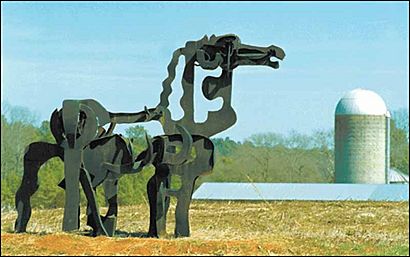Iron Horse (sculpture) facts for kids
The Iron Horse sculpture, also called Pegasus Without Wings, is a huge artwork made of iron. It weighs 2 tons (that's about 4,000 pounds!) and stands 12 feet tall, which is taller than a basketball hoop! A talented artist named Abbott Pattison created it. When it was first made, not everyone liked it. But today, many people, including tourists and students from the University of Georgia, visit this unique sculpture.
Contents
History of the Iron Horse
Early Days and Challenges
The Iron Horse was created on May 25, 1954. Its artist, Abbott Pattison, was working at the University of Georgia at the time. He first placed the sculpture outside Reed Hall on campus.
However, some students didn't like the sculpture. They damaged it, which is called vandalism. Because of this, the sculpture was secretly moved away. It was hidden in a barn for a while.
A New Home on a Farm
In 1959, a professor named L.C. Curtis moved the Iron Horse to his farm. This farm was located near Watkinsville, Georgia. Professor Curtis was a horticulture expert, meaning he studied plants.
In an interview, Professor Curtis explained why he wanted the sculpture. He said he liked to collect "conversation pieces." These are unique items that make people talk and ask questions. He also called himself "a little bit of an eccentric," meaning he had unusual interests.
Restoration and Protection
Years later, in 2011, the Iron Horse was damaged again. But this time, a secret group helped to fix it. They worked to restore the horse to its original condition.
The Curtis family, who owned the farm, took steps to protect the sculpture. They bolted it to a concrete pad. This made it much harder for people to knock it over.
The Horse's Future
Around 2012, the Curtis family sold a large part of their farm to the University of Georgia. However, they kept a small section of land where the Iron Horse stood. This section was about 20 feet by 20 feet.
The family then offered to give the horse and its small piece of land to the University. They had one condition: the horse had to stay right where it was. But the University wanted the sculpture to come back to its campus. As of January 2020, the two sides had not yet agreed on what to do.
Research at the Iron Horse Farm
Naming the Farm
In 2014, the University of Georgia officially named the land it bought from the Curtis family. It became known as the "Iron Horse Plant Sciences Farm." This name honors the famous sculpture that once stood there.
Agricultural Studies
The University uses this farm for important agricultural research. This means scientists study plants and farming methods there. They work to find better ways to grow crops and understand plant life.
For example, in 2017, a study from the farm was shared. This study used drones to help. Drones are like small flying robots. They were used to look at the genetic information in different crop yields. This helps scientists understand how to grow stronger and healthier crops.


